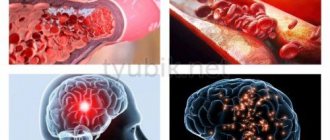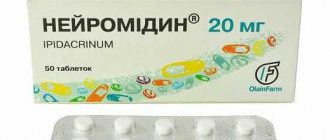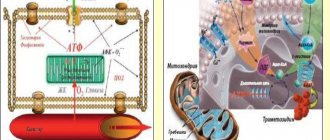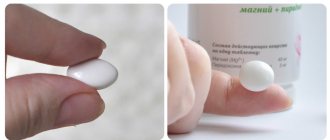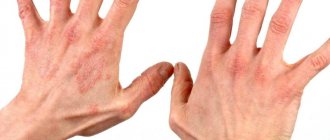pharmachologic effect
The active substance is verapamil hydrochloride. The drug is a derivative of diphenylalkylamine and belongs to the class I selective calcium channel blockers. It has antihypertensive, antiarrhythmic and antianginal effects.
The antianginal effect is caused by both a direct effect on the myocardium and an effect on peripheral geodynamics. By blocking the entry of calcium into the cell, Finoptin leads to a decrease in the transformation of the energy contained in it into mechanical action, thus reducing myocardial contractility.
Finoptin significantly reduces atrioventricular conduction and increases the refractory period. For supraventricular arrhythmias, it has an antiarrhythmic effect.
Release form and composition
Finoptin is available in the form of film-coated tablets:
- tablets 40 mg: biconvex, round, white, on one side with an engraving “VL40”, a white core without inclusions is visible on the break (30 pcs. or 100 pcs. in polyethylene bottles, one bottle in a cardboard pack);
- 80 mg tablets: biconvex, round, white, with “VL80” engraved on one side, a white core without inclusions is visible on the break (30 pcs. or 100 pcs. in polyethylene bottles, one bottle in a cardboard pack).
Composition of 1 tablet:
- active ingredient: verapamil (in the form of verapamil hydrochloride) – 40 mg or 80 mg;
- auxiliary components: gelatin, magnesium stearate, microcrystalline cellulose, colloidal silicon dioxide, lactose monohydrate;
- film shell: titanium dioxide, glycerol 85%, hypromellose, polysorbate 80, magnesium stearate, sucrose.
Side effects of Finoptin
From the cardiovascular system: pronounced decrease in blood pressure, tachycardia, bradycardia, worsening heart failure; rarely - myocardial infarction, angina pectoris, arrhythmia; with rapid intravenous administration - collapse, third degree atrioventricular block, asystole.
From the central nervous system and peripheral nervous system: depression, increased fatigue, dizziness, asthenia, anxiety, fainting, lethargy, drowsiness, headache, extrapyramidal disorders (tremor of the hands, mask-like face, ataxia, shuffling gait, difficulty swallowing, stiffness of the limbs ).
From the digestive system: increased appetite, constipation (rarely - diarrhea), nausea, gum hyperplasia.
Other possible side effects of Finoptin: weight gain, extremely rarely - gynecomastia, agranulocytosis, galactorrhea, hyperprolactinemia, arthritis, pulmonary edema, peripheral edema, asymptomatic thrombocytopenia.
Drug interactions
When Finoptin is used together with beta-blockers, antiarrhythmic drugs and drugs for inhalation anesthesia, the risk of developing arterial hypotension, bradycardia and heart failure increases. When verapamil is administered parenterally to patients who have previously received beta-blockers, there is a risk of developing arterial hypotension and asystole.
The combination of Finoptin with ACE inhibitors, vasodilators and thiazide diuretics helps to mutually enhance the antihypertensive effect.
In combination with disopyramide, severe arterial hypotension and collapse may occur.
In combination with acetylsalicylic acid, in some cases an increase in bleeding time occurs.
Phenytoin, diclofenac and phenobarbital can reduce the concentration of verapamil in the blood.
The simultaneous use of Finoptin and digoxin leads to an increase in the concentration of the latter in the blood plasma.
Cases of cardiac arrest have been reported when patients with arterial hypertension took verapamil and clonidine together.
The combination of Finoptin with etomidate and enflurane can lead to an increase in the duration of anesthesia.
special instructions
According to the instructions, Finoptin should be used with caution:
- with myocardial infarction with left ventricular failure;
- for chronic heart failure;
- with bradycardia;
- with AV block - 1st degree;
- with liver failure;
- with severe stenosis of the aortic mouth;
- with renal failure;
- with mild or moderate arterial hypotension;
- elderly patients;
- children and adolescents under 18 years of age.
Directions for use and dosage
The drug is taken orally during or after meals. The tablet should be swallowed whole with a small amount of water (do not chew or dissolve).
The dosage regimen of Finoptin and the duration of therapy are established by the attending physician after assessing the patient’s condition, the characteristics of the course of the disease and its severity, as well as the effectiveness of the treatment. The maximum daily dose of the drug is no more than 480 mg.
For arrhythmia (for the prevention of recurrent paroxysmal supraventricular tachycardia), the initial dose of Finoptin is usually 240–480 mg per day in 3–4 doses. For chronic atrial fibrillation or flutter, the daily dose of the drug is 240–320 mg in 3–4 doses. The maximum antiarrhythmic effect occurs within 48 hours from the start of treatment at the indicated doses.
For patients with angina pectoris, Finoptin is prescribed at an initial dose of 40–80 mg 3–4 times a day. In the future, it is possible to increase the dose weekly (for unstable angina - daily) until the required therapeutic effect is achieved. The average maintenance daily dose is 240–480 mg in 3–4 divided doses.
For arterial hypertension, the initial dose of the drug is 40–80 mg 3 times a day. Then it is possible to increase the dose weekly until the desired therapeutic effect is achieved. The average maintenance daily dose is 240–480 mg in 2–3 doses.
In elderly patients, a reduction in the usual dose may be necessary. In patients with severe liver failure, the dosage is reduced to 1/3 of the usual dose (up to 120 mg per day).
Overdose symptoms
An overdose of Finoptin or its analogue, Isoptin, can occur if the doses are selected incorrectly and the dosage regimen is not followed. Therefore, these drugs can only be purchased with a prescription. An overdose is manifested, first of all, by a sharp drop in blood pressure and an abnormal heart rhythm.
Due to disruption of normal blood circulation, tissue hypoperfusion occurs, and they begin to suffer without proper nutrition. Kidney hypoxia leads to metabolic disorders with the formation of huge under-oxidized products, which changes the normal acid-base and water-salt balance.
Depending on the age and condition of the patient, various symptoms of overdose are possible:
- dizziness and loss of consciousness;
- a feeling of interruptions in the work of the heart;
- development of seizures against the background of decreased potassium levels and increased blood glucose;
- cardiogenic shock;
- pulmonary edema;
- cardiac arrest and clinical death.
First aid for Finoptin poisoning is carried out only in a specialized department of a medical institution: intensive care or toxicology. The range of measures to take when the dose is exceeded depends on the patient’s consciousness. If the patient is available for productive contact, then first the stomach is washed and sorbents are used to remove residual Finoptin metabolic products.
Next, calcium preparations are administered, which is the pathogenetic antidote of Finoptin. A dose of 20 milliliters of calcium gluconate or chloride is prescribed intravenously. If it was not possible to achieve the effect with one injection, then it is repeated and an infusion system is connected for drip administration of calcium, the dose of which is specially calculated based on its indicators in a biochemical blood test.
Overdose therapy is aimed at eliminating the symptoms of poisoning, and most importantly, at preserving and maintaining adequate respiratory function and heartbeat. This also includes resuscitation measures: artificial respiration, chest compressions and restoration of normal heart rhythm using an automatic external defibrillator.
In case of conduction block in the atrioventricular node and bradycardia (less than 60 beats per minute), an atropine injection is prescribed. If a state of hypotension provoked by cardiogenic shock develops, then infusions of crystalloid solutions and bolus administration of dopamine are added at an average cardiotonic dose of 5 mcg/kg per minute.
An effective method for removing excess Finoptin from the blood is plasmapheresis.
Syncope in case of Finoptin overdose
Interactions with other medications
The effect of Finoptin is enhanced by: angiotensin-converting enzyme inhibitor drugs, nitrates, vasodilators, TD (thiazide-type diuretics), drugs containing the substance cimetidine.
The effect of the drug is reduced by medications containing phenobarbital, phenytoin, diclofenac and the hormone estrogen.
Simultaneous treatment with drugs containing digoxin, buspirone, doxorubicin, imipramine, carbamazepine, theophylline increases the amount of these substances in the patient’s blood.
During treatment with Finoptin, the following side effects may occur: chronic fatigue syndrome, increased fatigue, dizziness, migraine, nausea, stool disorders, increased appetite and, as a result, weight gain, retardation of movements, drowsiness, depressive states, excessive decrease in blood pressure, skin rash.
All these side effects disappear after stopping the medication.
Reception is contraindicated for:
- Individual intolerance to the components of this drug.
- Excessively low pressure.
- 2nd and 3rd degree AV block.
- SA blockade.
In the following cases, the drug must be taken with extreme caution:
- CHF.
- Pathologies of the liver and kidneys.
- Decreased heart rate.
- 1st degree of AV block.
- In old age.
- Persons under 18 years of age.
If the permissible dose is significantly exceeded (5-10 times) of the drug, characteristic symptoms such as convulsions, disorders of the nervous system and consciousness, vomiting, and severe decrease in blood pressure may appear half an hour or an hour after taking the drug.
In case of overdose, you should immediately call an ambulance or go to the nearest sanitary inspection station to receive emergency medical care.
The method of treatment used depends on the characteristics of the patient’s body and the severity of overdose symptoms. The most common procedure is gastric lavage (in mild cases); in severe cases, hospital treatment and intravenous administration of special drugs are prescribed.
Pregnancy and lactation
Taking this medication in the first period of pregnancy is strictly prohibited. During the rest of pregnancy, Finoptin therapy is allowed only in cases where the degree of possible risk to the fetus is justified by the therapeutic effect on the pregnant woman’s body.
During the lactation period, therapy with this medication is unacceptable.
Finoptin should be kept in a dry place, out of reach of children, away from other medications and away from direct sunlight.
The maximum storage temperature is 25 °C. Shelf life: 5 years.
The average cost of Finoptin tablets (0.04 mg, 30 tablets) in Russia is 70 rubles.
In Ukraine there are 30 tables. drugs in the same dosage cost an average of 80 UAH.
Analogues of the drug Finoptin are:
- Verapamil (Macedonia, Russia).
- Verohalid ER (Croatia).
- Verogalid EP (USA).
- Isoptin (Germany, USA).
- Isoptin SR (Germany).
- Isoptin SR (USA).
- Lekoptin (Yugoslavia).
- Kaveril (Yugoslavia).
- Veracard (Yugoslavia).
Finoptin can be replaced with a drug with a similar effect only after mandatory consultation with a doctor.
People who regularly take this drug in their reviews talk about its rapid therapeutic effect and affordable price. Below are several reviews of Finoptin from third-party online resources:
“I’ve been taking Finoptin for blood pressure for almost 5 years now, and by the way, I also had to take it during pregnancy (starting from the 2nd trimester).”
“Once upon a time I started taking it. I got side effects from it almost immediately and didn’t go away, so I had to quickly replace it with other pills.”
“Many people drink it for blood pressure, but I take it for angina. What will I say? Helps. It’s true that there were some side effects at first, but they quickly went away when I adjusted my dose together with the cardiologist. Now there are no heart problems, I’ve been taking the pills for a year now and will continue to do so.”
- Included in the class I BCC group (drugs that block calcium channels).
- The drug is a prescription drug.
- When starting to take Finoptin, you should refrain from driving a car or using complex machinery.
- When IV therapy with this medication requires regular diagnosis of blood pressure, heart rate, ECG, blood sugar, blood volume and urine volume.
- If you stop taking it abruptly, a state of “withdrawal syndrome” may occur.
- Made in Finland.
Features of the drug
When using the medicine "Finoptin", the instructions note some features.
Before starting to use the drug, it is important to compensate for heart failure.
During treatment you should:
- Keep the functioning of the cardiovascular system under control.
- Respiratory system.
- Keep your blood sugar levels under control.
- Monitor the level of electrolytes in the blood.
- Monitor the amount of urine excreted per day.
- OCC.
In this case, an increase in the PQ interval is possible if the concentration of the substance in plasma exceeds 30 ng/ml.
Severe hemodynamic effects have been observed in neonates.
Treatment should not be stopped abruptly. The drug is not addictive.
When you start taking the drug in the first 30-60 minutes, you may experience weakness and drowsiness. Therefore, during therapy, it is recommended not to drive, and also to be extremely careful when working with mechanisms that require increased attention.
It is strictly forbidden to drink alcohol during treatment with the drug.
